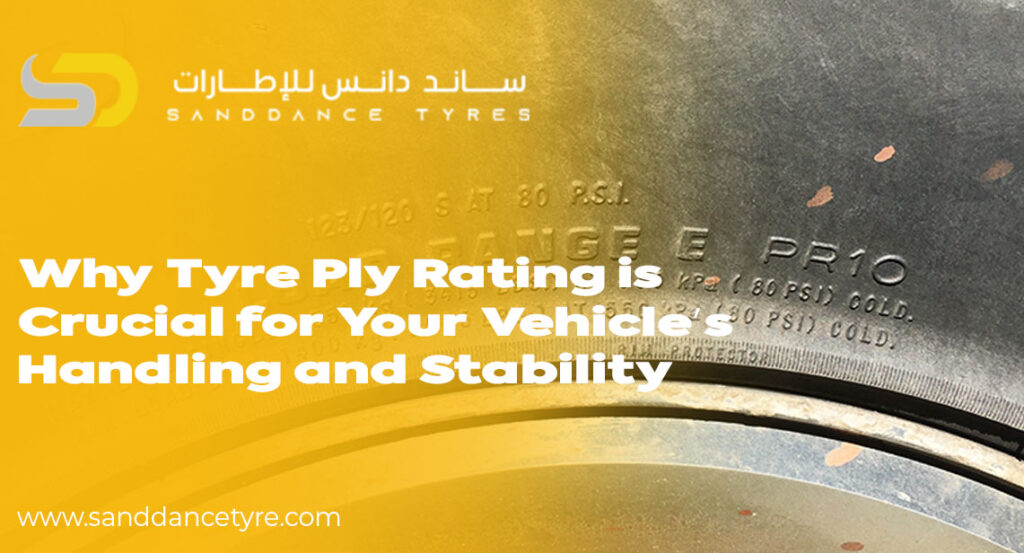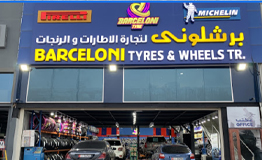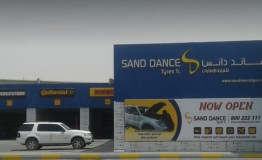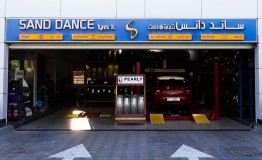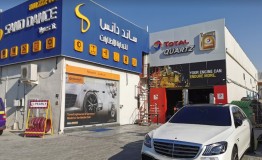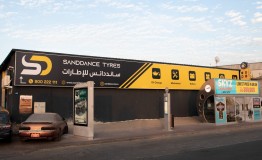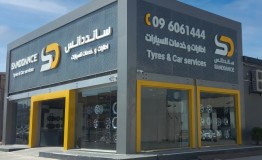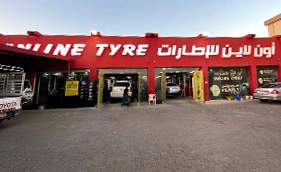When it comes to vehicle safety and performance, most drivers focus on tread patterns, tyre brands, or size. However, one factor that plays a key role in how your vehicle handles, grips, and performs under stress is the tyre ply rating.
Understanding tyre ply rating helps you choose the right tyres for your vehicle’s weight, load requirements, and driving conditions—especially in demanding environments like the UAE, where high temperatures and rough roads can test your tyres’ limits.
This guide explains what tyre ply rating means, why it matters, and how it impacts your car’s handling, stability, and safety.
1. What is Tyre Ply Rating?
The tyre ply rating refers to the number of layers, or “plies,” of fabric used in the tyre’s internal construction. These plies are made from materials like polyester, nylon, or steel cords that reinforce the rubber, giving the tyre its strength and flexibility.
Historically, tyre manufacturers used multiple layers of cotton plies. Today, advanced materials allow fewer layers to achieve higher strength—so “ply rating” now represents load capacity rather than literal layers.
For example:
- A 6-ply rating doesn’t mean there are six layers but that the tyre has the strength equivalent to six plies of traditional cotton fabric.
- Higher ply ratings indicate stronger tyres designed to carry heavier loads or withstand higher air pressure.
So, in simple terms, tyre ply rating = tyre strength and load-bearing capacity.
2. Why Tyre Ply Rating Matters for Vehicle Handling
Handling is all about how your car responds to steering, acceleration, and braking. The tyre ply rating directly affects these factors because it influences sidewall stiffness, grip, and overall tyre behavior.
Here’s how:
- Higher Ply Rating = Stiffer Sidewalls
Stiffer sidewalls reduce tyre flex during sharp turns, improving stability and steering precision. - Improved Load Handling
Tyres with higher ply ratings can handle heavier weights without losing balance or performance—crucial for SUVs, pickups, and commercial vehicles in the UAE. - Reduced Risk of Blowouts
In hot climates, tyre blowouts are common due to pressure buildup. A higher ply rating provides extra strength to withstand heat and pressure. - Better Control on Rough Terrain
Roads with gravel, potholes, or sand require tyres that can resist punctures. Tyres with stronger plies maintain structure even under rough conditions.
Simply put, ply rating affects not just durability, but also how safely and smoothly your vehicle handles.
3. Understanding Tyre Ply Rating Numbers
You’ll usually find the tyre ply rating on the tyre’s sidewall. It may look something like “10 PR,” where “PR” stands for “Ply Rating.”
Here’s a quick breakdown:
| Ply Rating | Equivalent Load Range | Typical Use |
| 4 PR | Load Range B | Small cars, passenger vehicles |
| 6 PR | Load Range C | Light trucks, vans |
| 8 PR | Load Range D | Medium-duty trucks |
| 10 PR | Load Range E | Heavy-duty trucks, off-road vehicles |
In modern tyres, manufacturers often use Load Range instead of Ply Rating, but the meaning remains similar—both indicate how much load a tyre can safely handle at a given air pressure.
4. Tyre Ply Rating and Vehicle Stability
Vehicle stability depends on how well the tyres maintain contact with the road under various conditions—acceleration, cornering, or braking. The tyre ply rating plays a critical role in ensuring consistent contact and even pressure distribution.
Let’s break this down:
- Cornering Stability:
Higher ply-rated tyres reduce sidewall flex, improving control when turning at high speeds. - Braking Performance:
Proper ply rating prevents tyre deformation under braking force, allowing shorter stopping distances. - Load Stability:
When carrying heavy loads, low-ply tyres may bulge or wobble, affecting balance. Correct ply rating keeps your vehicle steady even when fully loaded.
For UAE drivers, where long highway drives and high-speed travel are common, the right tyre ply rating ensures both comfort and safety. Here you can discover the 10 Most Important Highway Driving Tips in Dubai.
5. Tyre Ply Rating and Comfort
While higher ply ratings improve strength and stability, they can slightly reduce comfort. Stiffer tyres don’t absorb shocks as well as softer, lower-ply tyres.
Here’s what you should consider:
- Passenger Cars: 4–6 ply rating is ideal for comfort and efficiency.
- SUVs or Pickups: 6–10 ply rating works better for durability and load handling.
- Commercial Vehicles: 10–14 ply rating for maximum strength and performance.
Choosing the right balance between comfort and toughness is key—especially for UAE’s diverse driving conditions, from city roads to desert routes.
6. The Relationship Between Tyre Ply Rating and Fuel Efficiency
A tyre’s stiffness, influenced by ply rating, also impacts fuel efficiency.
- Lower Ply Rating (Softer Tyres):
Reduces rolling resistance → improves fuel efficiency → ideal for city driving. - Higher Ply Rating (Stiffer Tyres):
Increases rolling resistance slightly but offers durability and load safety → ideal for heavy vehicles and long-distance driving.
For example, an SUV used for family trips may benefit from medium ply-rated tyres, while delivery vans or 4x4s need higher ply ratings for load-bearing and off-road performance.
7. How to Check Your Tyre Ply Rating
You can find your tyre ply rating in two places:
- On the tyre sidewall, usually marked as “PR” or “Load Range.”
- In your vehicle owner’s manual, where the manufacturer specifies suitable tyre load ratings.
If your car manual recommends 6-ply tyres, using 4-ply ones can compromise safety and handling. Always match the recommended load range to your vehicle type and driving needs.
8. Common Misconceptions About Tyre Ply Rating
Let’s clear up a few myths drivers often believe about ply ratings:
- Myth 1: Higher ply always means better tyres.
Not necessarily. Overly stiff tyres can reduce comfort and fuel economy if your vehicle doesn’t require that load capacity. - Myth 2: Ply rating is the same as tyre pressure.
Wrong—tyre ply rating relates to construction strength, while pressure refers to air inside the tyre. - Myth 3: All tyres with the same size have the same ply rating.
Two tyres of the same size can have very different ply ratings based on design and purpose.
Understanding these differences helps you make smarter tyre choices.
9. Choosing the Right Tyre Ply Rating in the UAE
When buying new tyres, especially in the UAE, you should consider:
Vehicle Type: Passenger car, SUV, pickup, or commercial vehicle.
Driving Conditions: City, off-road, or long highway drives.
Load Requirements: Heavy cargo or light family use.
Weather and Terrain: UAE’s heat and sand require durable, heat-resistant tyres.
For most UAE drivers:
- Sedans: 4–6 ply rating
- SUVs: 6–8 ply rating
- Pickups/4x4s: 8–10 ply rating
Always buy from authorized tyre dealers in UAE who can recommend the best ply rating for your car model and usage.
10. The Risk of Ignoring Tyre Ply Rating
Using incorrect ply-rated tyres can lead to serious issues:
- Reduced handling and steering control
- Tyre blowouts due to overloading
- Uneven wear and shorter lifespan
- Poor braking performance
- Increased fuel consumption
In short, choosing the wrong tyre ply rating compromises not just performance but also safety—especially in high-temperature regions like the UAE.
Conclusion
Your vehicle’s tyres are the foundation of its safety, comfort, and control. While most drivers focus on brands or tread patterns, understanding tyre ply rating helps you make informed, performance-oriented decisions.
Whether you drive through Dubai’s highways or off-road trails, the right tyre ply rating ensures superior handling, stability, and load support—keeping you and your passengers safe in every journey.
If you’re planning to replace your tyres, visit a trusted tyre shop in UAE to check the correct ply rating for your vehicle and driving needs. Invest wisely—because strong tyres mean safer roads.
FAQs
1. What does tyre ply rating mean?
Tyre ply rating indicates the tyre’s load-carrying capacity and strength, represented by the number of plies or layers inside the tyre.
2. How do I know the right ply rating for my car?
Check your vehicle’s owner manual or the tyre sidewall for the recommended load range or ply rating suitable for your car.
3. Does a higher ply rating make the ride stiffer?
Yes, higher ply ratings provide strength and stability but may slightly reduce ride comfort due to stiffer sidewalls.
4. Is ply rating important for fuel efficiency?
Yes. Lower ply ratings reduce rolling resistance and improve fuel efficiency, while higher ply ratings are better for heavy loads.
5. Can I use higher ply-rated tyres than recommended?
It’s not ideal. Overly stiff tyres can affect suspension comfort and steering response unless your vehicle carries heavy loads regularly.


